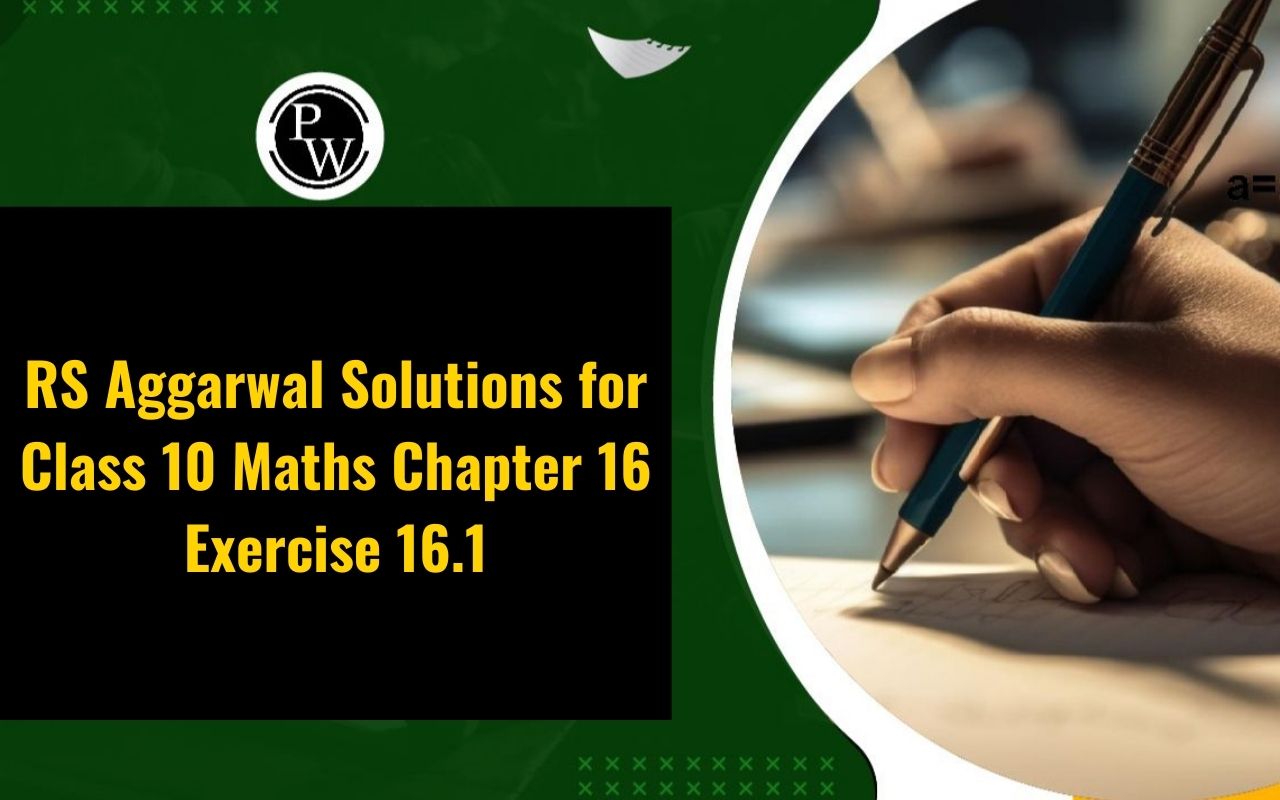

RD Sharma Solutions Class 10 Maths Chapter 8 Exercise 8.7: RD Sharma Class 10 Maths Chapter 8, Exercise 8.7 focuses on solving quadratic equations using factorization. The exercise provides various quadratic equations, where students need to find the values of by factoring the equation into two binomials.
The process involves finding factors of the product of the coefficient of (a) and the constant term (c), such that their sum equals the coefficient of x (b). The exercise reinforces the application of factorization techniques to solve quadratic equations efficiently.RD Sharma Solutions Class 10 Maths Chapter 8 Exercise 8.7 Overview
RD Sharma Solutions for Class 10 Maths, Chapter 8, Exercise 8.7 focuses on solving quadratic equations by various methods such as factorization, completing the square, and using the quadratic formula. This exercise is crucial for building a solid foundation in algebra, as quadratic equations frequently appear in both academic exams and real-world problem-solving scenarios. Mastering these methods helps students understand the nature of quadratic equations, identify their roots, and apply these concepts in fields like physics, engineering, and economics. A firm grasp of quadratic equations is vital for higher education, especially in mathematics and related subjects.RD Sharma Solutions Class 10 Maths Chapter 8 Exercise 8.7 PDF
Below, we have provided the PDF solution for Exercise 8.7 of Chapter 8, "Quadratic Equations," from RD Sharma's Class 10 Maths. This exercise focuses on various methods to solve quadratic equations, such as factorization, completing the square, and using the quadratic formula. The PDF contains step-by-step solutions for each problem, helping students understand the concepts clearly and improve their problem-solving skills. Download the PDF for detailed explanations.RD Sharma Solutions Class 10 Maths Chapter 8 Exercise 8.7 PDF
RD Sharma Solutions Class 10 Maths Chapter 8 Exercise 8.7 Quadratic Equations
Below is the RD Sharma Solutions Class 10 Maths Chapter 8 Exercise 8.7 Quadratic Equations -1. Find two consecutive numbers whose squares have the sum of 85.
Solution:
Let the two consecutive be considered as (x) and (x +1), respectively. Given that, The sum of their squares is 85. Expressing the same by equation, we have, x 2 + (x + 1) 2 = 85 ⇒ x 2 + x 2 + 2x + 1 = 85 ⇒ 2x 2 + 2x + 1 – 85 = 0 ⇒ 2x 2 + 2x – 84 = 0 ⇒ 2(x 2 + x – 42) = 0 Solving for x by factorization method, we get x 2 + 7x – 6x – 42 = 0 ⇒ x(x + 7) – 6(x + 7) = 0 ⇒ (x – 6)(x + 7) = 0 Now, either, x – 6 = 0 ⇒ x = 6 Or, x + 7 = 0 ⇒ x = -7 Thus, the consecutive numbers whose sum of squares can be (6, 7) or (-7, -6).2. Divide 29 into two parts so that the sum of the squares of the parts is 425.
Solution:
Let’s assume that one part is (x), so the other part will be (29 – x). From the question, the sum of the squares of these two parts is 425. Expressing the same by equation, we have, x 2 + (29 – x) 2 = 425 ⇒ x 2 + x 2 + 841 + -58x = 425 ⇒ 2x 2 – 58x + 841 – 425 = 0 ⇒ 2x 2 – 58x + 416 = 0 ⇒ x 2 – 29x + 208 = 0 Solving for x by factorization method, we get x 2 – 13x – 16x + 208 = 0 ⇒ x(x – 13) – 16(x – 13) = 0 ⇒ (x – 13)(x – 16) = 0 Now, either x – 13 = 0 ⇒ x = 13 Or, x – 16 = 0 ⇒ x = 16 Thus, the two parts whose sum of the squares is 425 are 13 and 16, respectively.3. Two squares have sides x cm and (x + 4) cm. The sum of their areas is 656 cm 2 . Find the sides of the squares.
Solution:
Given, The sides of the two squares are = x cm and (x + 4) cm, respectively. The sum of the areas of these squares = 656 cm 2 We know that, Area of the square = side * side So, the areas of the squares are x 2 and (x + 4) 2 . From the given condition, x 2 + (x + 4) 2 = 656 ⇒ x 2 + x 2 + 8x + 16 = 656 ⇒ 2x 2 + 8x – 640 = 0 ⇒ x 2 + 4x – 320 = 0 [dividing by 2 on both sides] Solving for x by factorization method, x 2 + 20x – 16x – 320 = 0 ⇒ x(x + 20) – 16(x + 20) = 0 ⇒ (x + 20)(x –16) = 0 Now, either x + 20 = 0 ⇒ x = – 20 Or, x – 16 = 0 ⇒ x = 16 No negative value is considered as the value of the side of the square can never be negative. Thus, the side of the square is 16. And, x + 4 = 16 + 4 = 20 cm Therefore, the side of the other square is 20 cm.4. The sum of two numbers is 48 and their product is 432. Find the numbers.
Solution:
Given that the sum of two numbers is 48. So, assuming one number to be x, then the other number will be 48 – x Also, given that their product is 432. Which means, x(48 – x) = 432 ⇒ 48x – x 2 = 432 ⇒ x 2 – 48x + 432 = 0 Solving for x by factorization method, ⇒ x 2 – 36x – 12x + 432 = 0 ⇒ x(x – 36) – 12(x – 36) = 0 ⇒ (x – 36)(x – 12) = 0 Now, either x – 36 = 0 ⇒ x = 36 Or, x – 12 = 0 ⇒ x = 12 Therefore, the two numbers are 12 and 36, respectively.5. If an integer is added to its square, the sum is 90. Find the integer with the help of quadratic equation.
Solution:
Assume the integer is x. Then its square will be x 2 . And given their sum is 90 ⇒ x + x 2 = 90 ⇒ x 2 + x – 90 = 0 Solving for x by factorization method, we have x 2 + 10x – 9x – 90 = 0 ⇒ x(x + 10) – 9(x + 10) = 0 ⇒ (x + 10)(x – 9) = 0 Now, either x + 10 = 0 ⇒ x = –10 Or, x – 9 = 0 ⇒ x = 9 Thus, the values of the integer are 9 and -10, respectively.6. Find the whole number which when decreased by 20 is equal to 69 times the reciprocal of the number.
Solution:
Let the whole number be x. When it is decreased by 20 ⇒(x – 20) And the reciprocal of the whole number is 1/x From the given condition, we have (x – 20) = 69 x (1/x) ⇒ x(x – 20) = 69 ⇒ x 2 – 20x – 69 =0 Solving for x by factorization method, we have ⇒ x 2 – 23x + 3x – 69 = 0 ⇒ x(x – 23) + 3(x – 23) = 0 ⇒ (x – 23)(x + 3) = 0 Thus, x is either 23 Or -3 As we know, a whole number is always positive. So, x = – 3 is not considered. Therefore, the whole number is 23.7. Find two consecutive natural numbers whose product is 20.
Solution:
Let the two consecutive natural numbers be x and x + 1, respectively. Given that their product is 20. Which means, x(x + 1) = 20 ⇒ x 2 + x – 20 = 0 Solving for x by factorization method, we have ⇒ x 2 + 5x – 4x – 20 = 0 ⇒ x(x + 5) – 4(x + 5) = 0 ⇒ (x + 5)(x – 4) = 0 Now, either x + 5 = 0 ⇒ x = – 5 Or, x – 4 = 0 ⇒ x = 4 Considering only the positive value of x since it a natural number. i.e, x = 4 Thus, the two consecutive natural numbers are 4 and 5, respectively.8. The sum of the squares of two consecutive odd positive integers is 394. Find them.
Solution:
Let’s assume the consecutive odd positive integer to be 2x – 1 and 2x + 1, respectively. [Keeping the common difference as 2] Now, it’s given that the sum of their squares is 394. Which means, (2x – 1) 2 + (2x + 1) 2 = 394 4x 2 +1 – 4x + 4x 2 +1 + 4x = 394 By cancelling out the equal and opposite terms, we get 8x 2 + 2 = 394 8x 2 = 392 x 2 = 49 x = 7 and – 7 Since we need only consecutive odd positive integers, we only consider x = 7. Now, 2x – 1 = 14 -1 = 13 2x + 1 = 14 + 1 = 15 Thus, the two consecutive odd positive numbers are 13 and 15, respectively.9. The sum of two numbers is 8 and 15 times the sum of the reciprocal is also 8. Find the numbers.
Solution:
Let the tone of the number be x so the other number will be (8 – x) as given their sum is 8. Also given, 15 times the sum of their reciprocals is 8. Which means, ⇒ 120 = 8(8x – x
2
)
⇒ 120 = 64x – 8x
2
⇒ 8x
2
– 64x + 120 = 0
⇒ 8(x
2
– 8x + 15) = 0
⇒ x
2
– 8x + 15 = 0
Solving for x by factorization method, we have
⇒ x
2
– 5x – 3x + 15 = 0
⇒ x(x – 5) – 3(x – 5) = 0
⇒ (x – 5)(x – 3) = 0
Now, either x – 5 = 0 ⇒ x = 5
Or, x – 3 = 0 ⇒ x = 3
Thus, the two numbers are 5 and 3, respectively.
⇒ 120 = 8(8x – x
2
)
⇒ 120 = 64x – 8x
2
⇒ 8x
2
– 64x + 120 = 0
⇒ 8(x
2
– 8x + 15) = 0
⇒ x
2
– 8x + 15 = 0
Solving for x by factorization method, we have
⇒ x
2
– 5x – 3x + 15 = 0
⇒ x(x – 5) – 3(x – 5) = 0
⇒ (x – 5)(x – 3) = 0
Now, either x – 5 = 0 ⇒ x = 5
Or, x – 3 = 0 ⇒ x = 3
Thus, the two numbers are 5 and 3, respectively.
10. The sum of a number and its positive square root is 6/25. Find the numbers.
Solution:
Let the number be x. According to the question, we have Let us assume that x = y
2
,
So, we get
y
2
+ y = 6/25
⇒ 25y
2
+ 25y – 6 = 0
⇒ 25y
2
+ 30y – 5y – 6 = 0
⇒ 5y(5y + 6) – 1(5y + 6)
= 0
⇒ (5y + 6) (5y – 1)
= 0
Now, either 5y + 6 = 0 ⇒ y = -6/5
Or, 5y – 1 = 0 ⇒ y = 1/5
Since it’s given that only positive square root is to be considered, we take y = 1/5 only
Thus, x = (1/5)
2
= 1/25
Hence, the number is 1/25.
Let us assume that x = y
2
,
So, we get
y
2
+ y = 6/25
⇒ 25y
2
+ 25y – 6 = 0
⇒ 25y
2
+ 30y – 5y – 6 = 0
⇒ 5y(5y + 6) – 1(5y + 6)
= 0
⇒ (5y + 6) (5y – 1)
= 0
Now, either 5y + 6 = 0 ⇒ y = -6/5
Or, 5y – 1 = 0 ⇒ y = 1/5
Since it’s given that only positive square root is to be considered, we take y = 1/5 only
Thus, x = (1/5)
2
= 1/25
Hence, the number is 1/25.
11. The sum of a number and its square is 63/4, Find the numbers.
Solution:
Let the number be x. So, its square will be x 2 . From the question, it’s given that sum of the number, and its square is 63/4 Which means, x + x 2 = 63/4 ⇒ 4x + 4x 2 = 63 ⇒ 4x 2 + 4x – 63 = 0 Solving for x by factorization method, we have ⇒ 4x 2 + 18x – 14x – 63 = 0 ⇒ 2x(2x + 9) – 7(2x – 9) = 0 ⇒ (2x – 7)(2x + 9) = 0 Now, either 2x -7 = 0 ⇒ x = 7/2 Or, 2x + 9 = 0 ⇒ x = -9/2 Thus, the numbers are 7/2 and -9/2.12. There are three consecutive integers such that the square of the first increased by the product of the other two gives 154. What are the integers?
Solution:
Let’s consider the three consecutive numbers to be x, x + 1, x + 2, respectively. And x is the first integer of the sequence. From the question, it’s understood that x 2 + (x + 1)(x + 2) = 154 ⇒ x 2 + x 2 + 3x + 2 = 154 ⇒ 2x 2 + 3x – 152 = 0 Solving for x by factorization method, we have ⇒ 2x 2 + 19x – 16x – 152 = 0 ⇒ x(2x + 19) – 8(2x – 19) = 0 ⇒ (2x – 19)(x – 8) = 0 Now, either 2x – 19 = 0 ⇒ x = 19/2 (which is not an integer) Or, x – 8 = 0 ⇒ x = 8 Hence, considering x = 8, the three consecutive integers are 8, 9 and 10.13. The product of two successive integral multiples of 5 is 300. Determine the multiples.
Solution:
Given that the product of two successive integral multiples of 5 is 300 Let’s assume the integers be 5x and 5(x+1), where x and x+1 are two consecutive multiples Then, according to the question, we have 5x[5(x + 1)] = 300 ⇒ 25x(x + 1) = 300 ⇒ x 2 + x = 12 ⇒ x 2 + x – 12 = 0 Solving for x by factorization method, we have ⇒ x 2 + 4x – 3x – 12 = 0 ⇒ x(x + 4) – 3(x + 4) = 0 ⇒ (x + 4)(x – 3) = 0 Now, either x + 4 = 0 ⇒ x = -4 Or, x – 3 = 0 ⇒ x = 3 For, x = – 4 5x = – 20 and 5(x + 1) = -15 And, for x = 3 5x = 15 and 5(x + 1) = 20 Thus, the two successive integral multiples can be 15, 20 or -15 and -20, respectively.14. The sum of the squares of two numbers is 233 and one of the numbers is 3 less than twice the other number. Find the numbers.
Solution:
Let one of the numbers be x. Then the other number will be 2x – 3. From the question: x 2 + (2x – 3) 2 = 233 ⇒ x 2 + 4x 2 + 9 – 12x = 233 ⇒ 5x 2 – 12x – 224 = 0 ⇒ 5x 2 – 40x + 28x – 224 = 0 ⇒ 5x(x – 8) + 28(x – 8) = 0 ⇒ (5x + 28) (x – 8) = 0 Now, 5x + 28 cannot be 0 so, x – 8 = 0 ⇒ x = 8 Considering the value of x = 8, we have 2x – 3 = 2(8) – 3 = 16 – 3 = 13 Thus, the two numbers are 8 and 13, respectively.15. Find the consecutive even integers whose squares have the sum 340.
Solution:
Let’s consider the three consecutive even numbers to be 2x and 2x + 2, respectively. From the question, it’s given that sum of the squares of these integers is 340. Which means, (2x) 2 + (2x + 2) 2 = 340 ⇒ 4x 2 + 4x 2 + 8x + 4 = 340 ⇒ 8x 2 + 8x – 336 = 0 ⇒ 8(x 2 + x – 42) = 0 ⇒ x 2 + x – 42 = 0 Solving for x by factorization method, we have ⇒ x 2 + 7x – 6x – 42 = 0 ⇒ (x + 7)(x – 6) = 0 Thus, x can be either -7 or 6. If x = -7, the number are -14 (2x(-7)) and -12 (2x(-7) + 2) Similarly, if x = 6, the numbers are 12 and 14. Therefore, the consecutive integers are either -14, -12 or 12, 14.16. The difference of two number is 4. If the difference of their reciprocals is 4/21, find the numbers.
Solution:
Let the two numbers be x and x – 4, respectively, since it is given that the difference between the two numbers is 4. Now, from the question, we have ⇒ 84 = 4x(x – 4)
⇒ x
2
– 4x – 21 = 0
Solving for x by factorization method, we have
⇒ x
2
– 7x + 3x – 21 = 0
⇒ (x – 7)(x + 3) = 0
Now, either x – 7 = 0 ⇒ x = 7
Or, x + 3 = 0 ⇒ x = -3
Thus, the required numbers are – 3 and 7, respectively.
⇒ 84 = 4x(x – 4)
⇒ x
2
– 4x – 21 = 0
Solving for x by factorization method, we have
⇒ x
2
– 7x + 3x – 21 = 0
⇒ (x – 7)(x + 3) = 0
Now, either x – 7 = 0 ⇒ x = 7
Or, x + 3 = 0 ⇒ x = -3
Thus, the required numbers are – 3 and 7, respectively.
17. Find two natural numbers which differ by 3 and whose squares have the sum 117.
Solution:
Let the numbers be x and x – 3, as it is given the number differ by 3. From the question, it’s given that sum of squares of these numbers is 117. x 2 + (x – 3) 2 = 117 ⇒ x 2 + x 2 + 9 – 6x – 117 = 0 ⇒ 2x 2 – 6x – 108 = 0 ⇒ x 2 – 3x – 54 = 0 Solving for x by factorization method, we have ⇒ x 2 – 9x + 6x – 54 = 0 ⇒ x(x – 9) + 6(x – 9) = 0 ⇒ (x – 9)(x + 6) = 0 Now, either x – 9 = 0 ⇒ x = 9 Or, x + 6 = 0 ⇒ x = – 6 Considering only the positive value of x as natural numbers are always positive, i.e., x = 9. So, x – 3 = 6. Thus, the two numbers are 6 and 9, respectively.18. The sum of the squares of three consecutive natural numbers is 149. Find the numbers.
Solution:
Let the three consecutive natural numbers be x, x + 1, and x + 2, respectively. From the question, we have x 2 + (x +1 ) 2 + (x + 2) 2 = 149 ⇒ x 2 + x 2 + x 2 + 1 + 2x + 4 + 4x = 149 ⇒ 3x 2 + 6x – 144 = 0 ⇒ x 2 + 2x – 48 = 0 [dividing by 3 on both sides] Solving for x by factorization method, we have x 2 + 8x – 6x – 48 = 0 ⇒ x(x + 8) – 6(x + 8) = 0 ⇒ (x + 8)(x – 6) = 0 Now, either x + 8 = 0 ⇒ x = – 8 Or, x – 6 = 0 ⇒ x = 6 Considering only the positive value of x, i.e. 6, and discarding the negative value as the numbers considered are natural numbers. So, x = 6, x + 1 = 7 and x + 2 = 8. Thus, the three consecutive numbers are 6, 7, and 8 respectively.19. The sum of two numbers is 16. The sum of their reciprocals is 1/3. Find the numbers.
Solution:
Let’s consider one of the two natural numbers as x, then the other number will be 16 – x, as it is given their sum is 16. Now, from the question we can form the below equation ⇒ 16x – x
2
= 48
⇒ -16x + x
2
+ 48 = 0
⇒ x
2
– 16x + 48 = 0
Solving for x by factorization method, we have
⇒ x
2
– 12x – 4x + 48 = 0
⇒ x(x – 12) – 4(x – 12) = 0
⇒ (x – 12)(x – 4) = 0
So, either x – 12 = 0 ⇒ x = 12
Or, x – 4 = 0 ⇒ x = 4
Thus, the two numbers are 4 and 12, respectively.
⇒ 16x – x
2
= 48
⇒ -16x + x
2
+ 48 = 0
⇒ x
2
– 16x + 48 = 0
Solving for x by factorization method, we have
⇒ x
2
– 12x – 4x + 48 = 0
⇒ x(x – 12) – 4(x – 12) = 0
⇒ (x – 12)(x – 4) = 0
So, either x – 12 = 0 ⇒ x = 12
Or, x – 4 = 0 ⇒ x = 4
Thus, the two numbers are 4 and 12, respectively.
20. Determine two consecutive multiples of 3 whose product is 270.
Solution:
Let the two consecutive multiples of 3 be 3x and 3x + 3 From the question, it’s given that 3x*(3x + 3) = 270 ⇒ x(3x + 3) = 90 [Dividing by 3 on both sides] ⇒ 3x 2 + 3x = 90 ⇒ 3x 2 + 3x – 90 = 0 ⇒ x 2 + x – 30 = 0 Solving for x by factorization method, we have x 2 + 6x – 5x – 30 = 0 ⇒ x(x + 6) – 5(x + 6) = 0 ⇒ (x + 6)(x – 5) = 0 Now, either x + 6 = 0 ⇒ x = – 6 Or, x – 5 = 0 ⇒ x = 5 Considering the positive value of x, we have only x = 5, so 3x = 15 and 3x + 3 = 18. Thus, the two consecutive multiples of 3 are 15 and 18, respectively.21. The sum of a number and its reciprocal is 17/4. Find the number.
Solution:
Let the number be x. Then from the question, we have x + 1/x = 17/4 ⇒ 4(x
2
+1) = 17x
⇒ 4x
2
+ 4 – 17x = 0
⇒ 4x
2
+ 4 – 16x – x = 0
⇒ 4x(x – 4) – 1(x – 4) = 0
⇒ (4x – 1)(x – 4) = 0
Now, either x – 4 = 0 ⇒ x = 4
Or, 4x – 1 = 0 ⇒ x = 1/4
Thus, the value of x is 4.
⇒ 4(x
2
+1) = 17x
⇒ 4x
2
+ 4 – 17x = 0
⇒ 4x
2
+ 4 – 16x – x = 0
⇒ 4x(x – 4) – 1(x – 4) = 0
⇒ (4x – 1)(x – 4) = 0
Now, either x – 4 = 0 ⇒ x = 4
Or, 4x – 1 = 0 ⇒ x = 1/4
Thus, the value of x is 4.
Benefits of Using RD Sharma Solutions Class 10 Maths Chapter 8 Exercise 8.7
Using RD Sharma Solutions for Class 10 Maths, Chapter 8, Exercise 8.7 (Quadratic Equations) offers several benefits to students:Step-by-Step Solutions : RD Sharma provides detailed, step-by-step explanations for solving each problem, helping students understand the process of solving quadratic equations clearly.
Concept Clarity : By following the solutions, students can strengthen their understanding of quadratic equations, including methods like factoring, using the quadratic formula, and completing the square.
Practice and Reinforcement : This exercise provides ample practice for solving quadratic equations, reinforcing the concepts learned in class and helping students build their problem-solving skills.
Time-Saving : The solutions are structured in a way that saves students time in understanding difficult problems, enabling them to focus on learning rather than struggling with complex steps.
Helps in Revision : These solutions can be used for quick revision before exams, allowing students to check their work and ensure they have the correct approach.
Boosts Confidence : When students are able to solve problems using the RD Sharma solutions, they build confidence in their ability to handle quadratic equations in the exam.
RD Sharma Solutions Class 10 Maths Chapter 8 Exercise 8.7 FAQs
Can a quadratic equation have one root?
What is the nature of the quadratic form?
Why are they called quadratic equations?
What is the formula for the quadrant?












